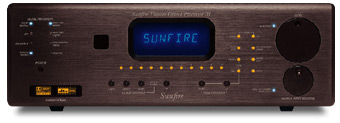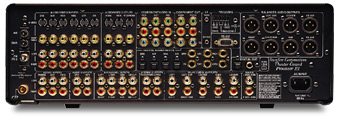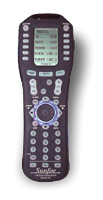
|

Sunfire
Theater Grand III
Surround-Sound Processor

|
|
|
 |

Description Model:
Sunfire Theater Grand III
Price: $3495 USD
Dimensions: 19"W x 15.75"D x 6.5"H
Weight: 25 pounds
Warranty: Two years parts and labor
Features
- Dolby Digital, Dolby Digital EX, DTS, DTS-ES, DTS Neo:6,
Dolby Pro Logic II
- 7-Axis mode
- Two-channel analog bypass mode
- Second zone can play sources independent of the main zone
- Eight-channel analog audio input for DVD-A or SACD
- Six audio/video inputs, each with audio, S-video, and
composite video
- Three audio-only inputs
|

Features (cont'd)
- MM phono input
- Digital audio (S/PDIF) inputs for six sources (four coax or
optical; two coax only)
- FM/AM tuner with Dynamic Noise Reduction and 40 presets
- Balanced outputs for primary 7.1 channels
- Four subwoofer outputs
- All-digital bass management with crossover frequencies
adjustable from 40Hz to 160Hz
- 24-bit A-to-D converter and 24-bit/192kHz D-to-A converters
- DSP tone controls
- Three 100MHz HDTV-compatible wide-bandwidth component-video
inputs and two outputs
- Preprogrammed learning remote control with LCD screen
- FLASH memory upgradeable via CD
- Auto signal-sensing input switching
- IEEE-1394 (Firewire™) port for future expansion
|
Bob Carver has made a nice career from creative solutions
to seemingly irresoluble problems. In the 1970s, he gave us ultra-high-powered amps
(relative to the time) from Phase Linear; finally, something could drive all those
low-efficiency speakers. By the 1980s, as the owner of Carver Electronics, he was fooling
golden-eared stereo-philes into believing he could make a solid-state amp sound like a
tube amp. Then, when sound fanatics had written him off as just a fancy engineer, he blew
everyone away with his $25,000 Carver Silver Seven tube amps. Harry Pearson of The
Absolute Sound even named the Silver Seven the "amp of the decade."
In the 1990s, Carver started a new company called Sunfire.
Then just to make sure we all noticed he was there, he created a one-cubic-foot subwoofer
that could shake your house, driven by a tiny, internal 2700W amp. He never seems to stop.
Just this year, he has created a receiver that will pump 2800W into 4 ohms through its
seven channels.
With all the recognition for his tricky inventions, it is
sometimes easy to forget that he makes a slew of other products: home-theater receivers,
amplifiers, processors, stereo amps, a tube preamp, and five different subwoofers. I
recently had the opportunity to spend a few months with his Sunfire Theater Grand III
surround-sound processor.
Look at all those lights . . .
When the box arrived, the first thing I noticed was an
outside label that specified "Architect’s Choice." It turns out that
Sunfire is trying to make itself user friendly to the pro-installer community. The regular
TGIII is 19"W x 6.5"H x 15.75"D. To make rack installation easier, the
Architect’s Choice is 2" narrower and .75" shorter. Other than the
dimensions, Sunfire states there is no difference.
The TGIII is well protected for shipping and came out
looking beautiful, even after UPS had mangled the box. It is a good-looking piece with a
beautiful, dark-charcoal finish and impeccable machining that lend the TGIII a look of
luxury. The front is covered with 30 lights, many of which do double duty as buttons (they
are the yellow lights in the picture). Add to that a good-sized blue display and you will
be thankful for the four-stage panel dimmer. There are also two large, flush-mounted
rotary knobs and a lighted panel that assures you that both Dolby Digital EX and DTS-ES
are included features. I find the look beautiful, if a little flashy. Visitors always
notice it and comment about it.
Even though Sunfire sent me the smaller version of the
TGIII, it still dwarfs my Lexicon MC-1. That large size pays benefits -- especially in the
connectivity arena. My big fingers finally have enough room to fit in the same spaces as
the interconnects. The additional size also allows for eight balanced outputs, which is
something you don’t always see, even in products that are more expensive.
 The connections are not
only simple, but also ample. I was especially glad to see ten digital inputs, a phono
stage, and four pairs of down-mixed stereo outputs. Unlike some other processors, where
you can set the software to pair one audio input with a different video input (as an
example, the CD audio could go with the DVD video), the TGIII’s video and audio
inputs are hard-wired together. Sure, it is less accommodating for folks who want to make
multiple types of connections from one component, but it also assures you the simplest
wiring. I will take the slight loss of flexibility for the huge increase in ease.
I’ll take simplicity any day. The connections are not
only simple, but also ample. I was especially glad to see ten digital inputs, a phono
stage, and four pairs of down-mixed stereo outputs. Unlike some other processors, where
you can set the software to pair one audio input with a different video input (as an
example, the CD audio could go with the DVD video), the TGIII’s video and audio
inputs are hard-wired together. Sure, it is less accommodating for folks who want to make
multiple types of connections from one component, but it also assures you the simplest
wiring. I will take the slight loss of flexibility for the huge increase in ease.
I’ll take simplicity any day.
Sunfire has also gone an extra step in providing a
first-class remote control. Universal Remote Control, Inc.’s Home Theater Master
MX-500 (normally $189) comes packaged with the TGIII, already programmed and utterly
simple to use. The large LCD screen gives you lots of information, is easy to read whether
in the dark or light, and has enough preprogrammed codes to cover almost any component.
You can control ten different components and develop multiple Einstein-level macros. One
thing I detest on other learning remotes is having to remember that a button that says one
thing actually does another. This remote allows you to re-label the buttons around the
LCD, something you generally don’t find except with touchscreen remotes. On top of
that, it has extensive programmability, mind-boggling signal strength, and fits
comfortably in my hand. This remote is so good that I haven’t even used my Philips
Pronto since the TGIII came in the door. Bravo to Sunfire for spending the money to
provide this useful addition.
Setup was simple, but don’t lose that manual. I found
a couple of the menu items just slightly confusing. For example, under "Modes"
on the main menu is a sub-menu labeled "Dolby S/DTS Dyn Rng" and the choices are
"Large," "Medium," and "Quiet." This applies to a built-in
dynamic-range compressor, which made sense after I read it. Nevertheless, I had to
read it. As with any sophisticated piece of equipment, it is wise to study the manual
once, then use the TGIII for a few weeks, then go back and read the manual again. Several
things I wished for during the first two weeks of use were actually available, but buried
in the manual.
 There was one oddity. I
was longing for a way to change the volume of both the Main Zone and Zone 2 from the front
panel, without having to get the remote. Sunfire took the time to add a really useful
feature in the form of a totally independent Zone 2. Both the Main Zone and Zone 2 can be
fed from any input, so one person could be watching a DVD in the main home theater while
another was listening to music on the porch. However, there was nothing in the manual
about how to control the volume from the front panel, and I couldn’t figure it out. I
didn’t think Sunfire would leave this out, so I put in a call to tech support. Turns
out the button marked Zone 2 is a toggle that allows the volume changes, but you have to
start with the TGIII in the "Main" mode. That should be addressed in the next
version of the manual. There was one oddity. I
was longing for a way to change the volume of both the Main Zone and Zone 2 from the front
panel, without having to get the remote. Sunfire took the time to add a really useful
feature in the form of a totally independent Zone 2. Both the Main Zone and Zone 2 can be
fed from any input, so one person could be watching a DVD in the main home theater while
another was listening to music on the porch. However, there was nothing in the manual
about how to control the volume from the front panel, and I couldn’t figure it out. I
didn’t think Sunfire would leave this out, so I put in a call to tech support. Turns
out the button marked Zone 2 is a toggle that allows the volume changes, but you have to
start with the TGIII in the "Main" mode. That should be addressed in the next
version of the manual.
Music and films
Task number one for the video section of any good processor
is Primum non nocere -- first do no harm. We all crave the convenience of using the
processor as a video switcher, but only if there is no degradation to the picture. I used
the Boxlight Studio Experience 20HD both with the TGIII providing the video, and with a
direct component connection from the DVD player to the projector. With everything set and
adjusted, I started with Austin Powers: The Spy Who Shagged Me. Chapter 10 with its
bold primary colors and extensive rapid panning across hard lines is a true torture test.
I tried both the Panasonic DVD CP-72 and Ayre D-1x. After changing the wiring eight times,
I couldn’t detect any difference between the direct-wired and TGIII-derived signals.
Next, I switched to La Traviata. The
video is exceptionally clean and has a number of close-ups where you can almost see
into the singers’ pores. Again, no difference. Next, I switched out the projector and
tried the PLUS Piano
Avanti HE-3200. The Ayre/Avanti in direct-connect mode produces the most beautiful DVD
picture I’ve seen. In this case, there was still no repeatable difference between
using the direct connection and running it through the TGIII. I thought I could see a slight
decrease in detail when running through the TGIII, but I only saw it on skin textures and
then the difference was so small as to be nearly non-existent. The bottom line is that the
video switching on the TGIII is virtually invisible.
When I switched over to the S-video output to watch some
high-brow entertainment (South Park, The Man Show) on TiVo, I noticed some
troubling upright lines, almost like a watermark on the screen. I also found that the
TGIII’s setup menus wouldn’t synchronize with the Avanti. I tried everything I
could think of. After running a full trouble-shooting sequence, I determined the cause was
the onscreen display; turn it off and the lines disappear, turn it back on and they
reappear.
I contacted Sunfire about the problem and found that they,
too, had discovered the trouble. They offered to overnight me a special beta software
update, but I asked to wait and get the final consumer version. It arrived about three
weeks later in the form of a CD. This is one of the neatest of Bob Carver’s
inventions. All you do is put the CD in a player using its digital outs, push a couple of
buttons, and the entire system software is upgraded. After struggling with other brands
and their chip changes and downtime, this was a great step forward in easing the update
process. Unfortunately, it only improved the problem, it didn’t solve it. The menus
would synchronize, but the lines were still there. Since the difficulty only occurred with
the Avanti, not the Boxlight or Runco, I can only assume that the problem lies with the
combination of the two pieces. Luckily, it only cropped up when using the S-video outs
from the TGIII; the DVD picture through the component output was still gorgeous.
Here is the big surprise. Have you ever caught a whiff of
something that you hadn’t smelled in years, but you immediately recognized it? Or
seen a face from your past and immediately identified it? The second I started playing my
usual test recordings, I got more than just a hint of the sound of one of my favorite
preamps, one that I lived with for seven years, the Jeff Rowland Consonance. I heard an
open soundstage, clean and lifelike instrumental timbre, accurate depth and just the
tiniest bit of darkness (as in the opposite of bright). The other aspect of the sound
present in both the TGIII and the Consonance was the almost eerie lack of noise. I was
constantly reaching for more and more music -- very high praise for a processor that does
all the things the TGIII does.
For years, I’ve used the Shaw recording of Carmina
Burana [Telarc 80056] as an imaging test. Track 4, from eight minutes until the end,
has everything from soloists to the full orchestra and chorus, and a soundstage captured
with laser exactitude. The TGIII reproduced the power and precision on this recording
better than anything I had heard in years.
Old vinyl sounded great through the TGIII’s phono
stage. A "Six Eye" Kind of Blue [Columbia CS-8163] produced a woody, deep
throb from Paul Chamber’s bass on "So What." New Order’s 12" 45
of "Bizarre Love Triangle" (Brotherhood [Qwest 25511]) rocked like crazy,
and when the sampled chorus came in, the weird phase relationships sent the sound all over
the room.
Speaking of sound all over the room, surround music also
sounded great. I had seen Diana Krall just two weeks before her DVD Live in Paris
was released. Both the sound and look were fresh in my mind. Through the TGIII, the
enveloping sound was just wonderful, and better than through the system in the concert
hall.
On the Eagles’ Hell Freezes Over, during
"Hotel California," Glen Frey’s 12-string and Don Felder’s plucked
nylon-string guitar are very realistically recorded. Felder’s guitar has tremendous
impact through the TGIII. This song also has some delicate but effective soundstage
manipulation. Notice the synth moving around in the back channels. The TGIII catches it
perfectly.
Let’s compare
The Lexicon MC-1 was a great piece of equipment in 1999. At
$5999, it offered good sound, lots of control flexibility, and convenience. The unit was
small, light, and easy to set-up. But it’s now 2003, and I have to say I prefer the
Sunfire in every aspect. Most important to me is the sonic purity of the TGIII. Switching
back to the MC-1 left me feeling as if I was hearing substantially more odd-harmonic
distortion. In old audio terms, the TGIII sounded tube-like compared to the MC-1’s
transistor sound. Also, depth of field and separation of instruments was superior on the
TGIII.
The TGIII also has eight-channel analog inputs, XLR
balanced outputs, the newest forms of Dolby Digital and DTS, two-channel analog bypass and
a huge number of foolproof inputs, all of which are missing in action from the MC-1. It is
also more substantial and richer looking. The coup de grace in this comparison is
the superior remote control, and there is no comparison. All this and the TGIII is $2500
less!
Conclusion
In the under-$6000 price range, the TGIII is something you
simply have to audition. Except for owners of the PLUS Avanti, or people averse to lots of
lights, there is really nothing negative of import to say. The TGIII looks great, makes a
beautiful picture, and is simple to use. Perhaps most important of all, the TGIII is a
super-sounding audiophile preamp as well as a great home-theater processor. Highly
recommended.
| Review
System |
| Speakers - ATC SMC 50A (mains),
Sonance Symphony (surrounds), KEF Model 100 (center-channel), Sunfire True Subwoofer
Signature |
| Amplifier
- B&K Video 5 |
| Sources - Pioneer DV-434 DVD player,
Panasonic DVD CP-72 DVD player, Ayre D-1x DVD player, Rega P-25, Rega Super Elys
cartridge, Musical Fidelity XLPS phono stage |
| DirecTV/TiVo
- Philips DSR6000 |
| Cables - Canare, Monster Cable,
Straight Wire |
| Projectors
- Runco Cinema 750, Boxlight Studio Experience Cinema 20HD, PLUS Piano Avanti HE-3200 |
|
|

